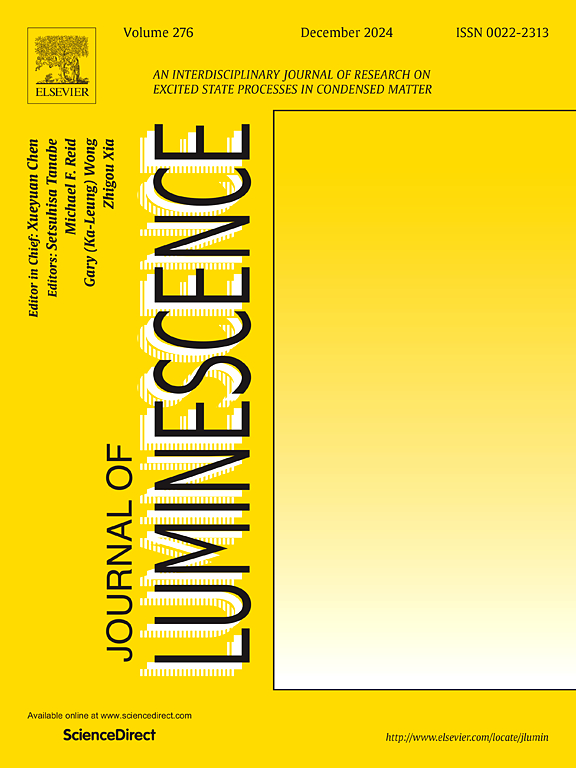Modulating the embedding position of nitrogen atom in [5]helicene:the design of hot-exciton materials
IF 3.3
3区 物理与天体物理
Q2 OPTICS
引用次数: 0
Abstract
The introduction of helical chirality is of great significance for improving the luminescence performance of circularly polarized thermally activated delayed fluorescence (CP-TADF) materials. The current work provides valuable design strategy to develop efficient “hot” exciton TADF molecules with CPL characteristics. A novel class of nitrogen-embedded [5]helicene compounds is designed by adjusting the positions of the nitrogen atom, named [5]H-PTZ, 1-aza[5]H-PTZ, 2-aza[5]H-PTZ, and 3-aza[5]H-PTZ. By employing density functional theory (DFT) and time-dependent DFT (TD-DFT) calculations, we focus on investigating the profound impact of specific nitrogen atom positions within the [5]helicene framework on the electronic properties. Intriguingly, when the nitrogen atom resides near the donor position in 3-aza[5]H-PTZ, the higher-lying singlet-triplet energy gap (ΔEST) approaches almost 0 eV. The small ΔEST values (the ΔES1T2 = 0.07 eV, ΔES1T3 = 0.0003 eV, ΔES1T4 = 0.03 eV, ΔES1T5 = 0.04 eV) facilitate a heightened participation of triplet excited states in the luminescence process. Notably, 3-aza[5]H-PTZ exhibits the radiation rate (kr) value as large as 4.79 × 107 s−1. Particularly, the luminescence asymmetry factor (glum) of the 3-aza[5]H-PTZ reaches 3.90 × 10−3. Therefore, the advantage of [5]helicene as a chiral molecule exhibits CPL characteristic. By precisely controlling nitrogen atom positions, this work highlights design strategies for modulating CPL and “hot” exciton TADF properties.

调节[5]螺旋烯中氮原子的嵌入位置:热激子材料的设计
螺旋手性的引入对于提高圆极化热激活延迟荧光(CP-TADF)材料的发光性能具有重要意义。目前的工作为开发具有CPL特性的高效“热”激子TADF分子提供了有价值的设计策略。通过调整氮原子的位置,设计了一类新的含氮螺旋烯化合物[5]H-PTZ、1-aza[5]H-PTZ、2-aza[5]H-PTZ和3-aza[5]H-PTZ。通过密度泛函理论(DFT)和时间依赖DFT (TD-DFT)计算,我们重点研究了[5]螺旋烯框架内特定氮原子位置对电子性质的深刻影响。有趣的是,当氮原子位于3-aza[5]H-PTZ的供体位置附近时,高能级的单重态-三重态能隙(ΔEST)接近于0 eV。较小的ΔEST值(ΔES1T2 = 0.07 eV, ΔES1T3 = 0.0003 eV, ΔES1T4 = 0.03 eV, ΔES1T5 = 0.04 eV)有助于提高三重态激发态在发光过程中的参与度。值得注意的是,3-aza[5]H-PTZ的辐射率(kr)值高达4.79 × 107 s−1。特别是,3-aza[5]H-PTZ的发光不对称因子(glum)达到3.90 × 10−3。因此,[5]螺旋烯作为手性分子的优势表现为CPL特性。通过精确控制氮原子位置,本工作强调了调制CPL和“热”激子TADF特性的设计策略。
本文章由计算机程序翻译,如有差异,请以英文原文为准。
求助全文
约1分钟内获得全文
求助全文
来源期刊

Journal of Luminescence
物理-光学
CiteScore
6.70
自引率
13.90%
发文量
850
审稿时长
3.8 months
期刊介绍:
The purpose of the Journal of Luminescence is to provide a means of communication between scientists in different disciplines who share a common interest in the electronic excited states of molecular, ionic and covalent systems, whether crystalline, amorphous, or liquid.
We invite original papers and reviews on such subjects as: exciton and polariton dynamics, dynamics of localized excited states, energy and charge transport in ordered and disordered systems, radiative and non-radiative recombination, relaxation processes, vibronic interactions in electronic excited states, photochemistry in condensed systems, excited state resonance, double resonance, spin dynamics, selective excitation spectroscopy, hole burning, coherent processes in excited states, (e.g. coherent optical transients, photon echoes, transient gratings), multiphoton processes, optical bistability, photochromism, and new techniques for the study of excited states. This list is not intended to be exhaustive. Papers in the traditional areas of optical spectroscopy (absorption, MCD, luminescence, Raman scattering) are welcome. Papers on applications (phosphors, scintillators, electro- and cathodo-luminescence, radiography, bioimaging, solar energy, energy conversion, etc.) are also welcome if they present results of scientific, rather than only technological interest. However, papers containing purely theoretical results, not related to phenomena in the excited states, as well as papers using luminescence spectroscopy to perform routine analytical chemistry or biochemistry procedures, are outside the scope of the journal. Some exceptions will be possible at the discretion of the editors.
 求助内容:
求助内容: 应助结果提醒方式:
应助结果提醒方式:


